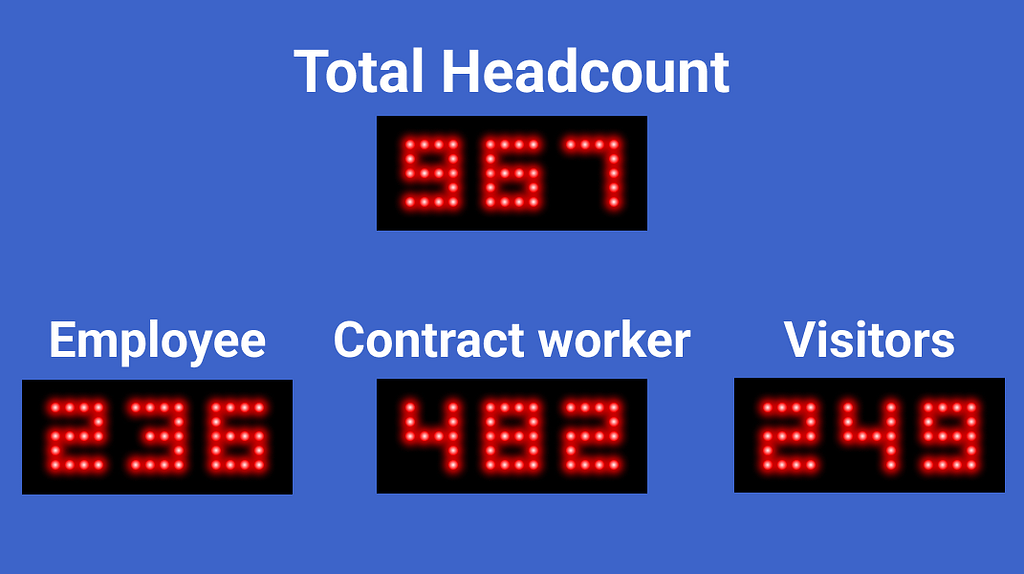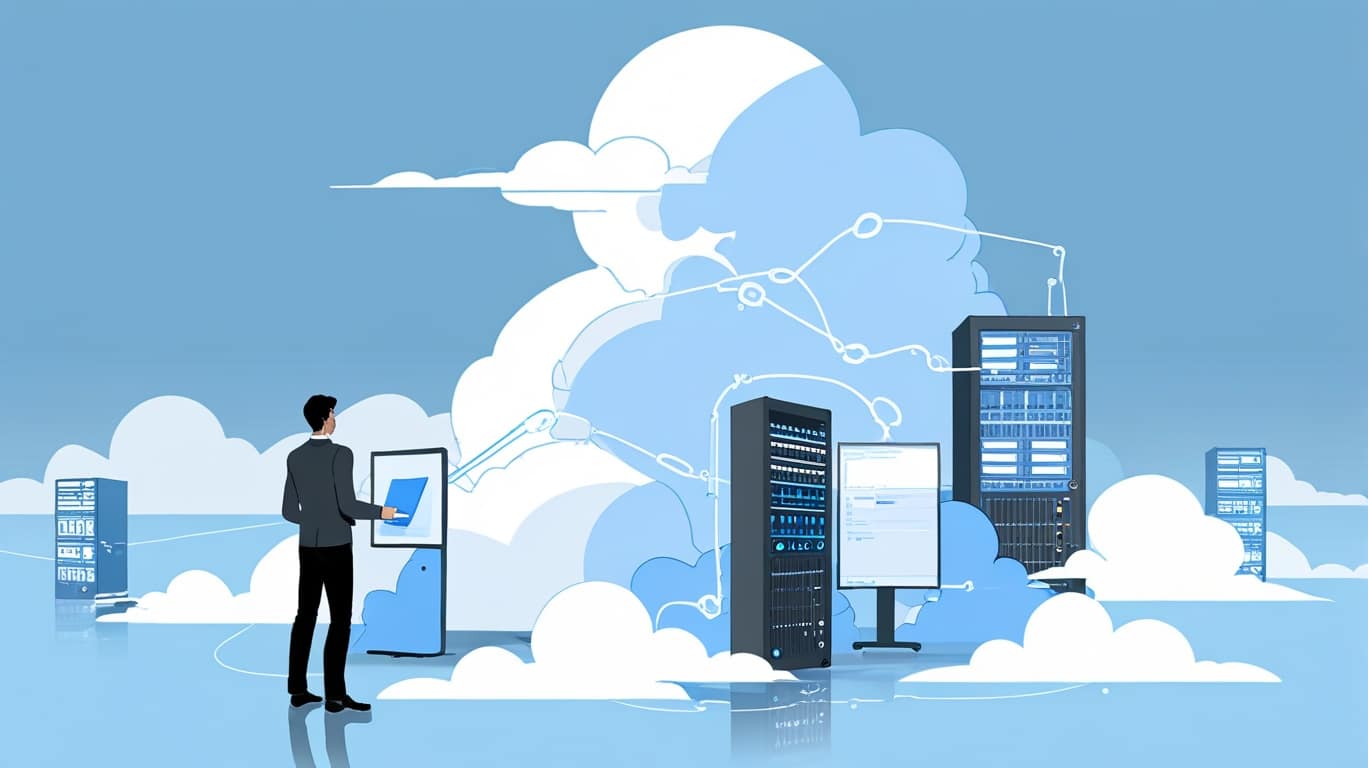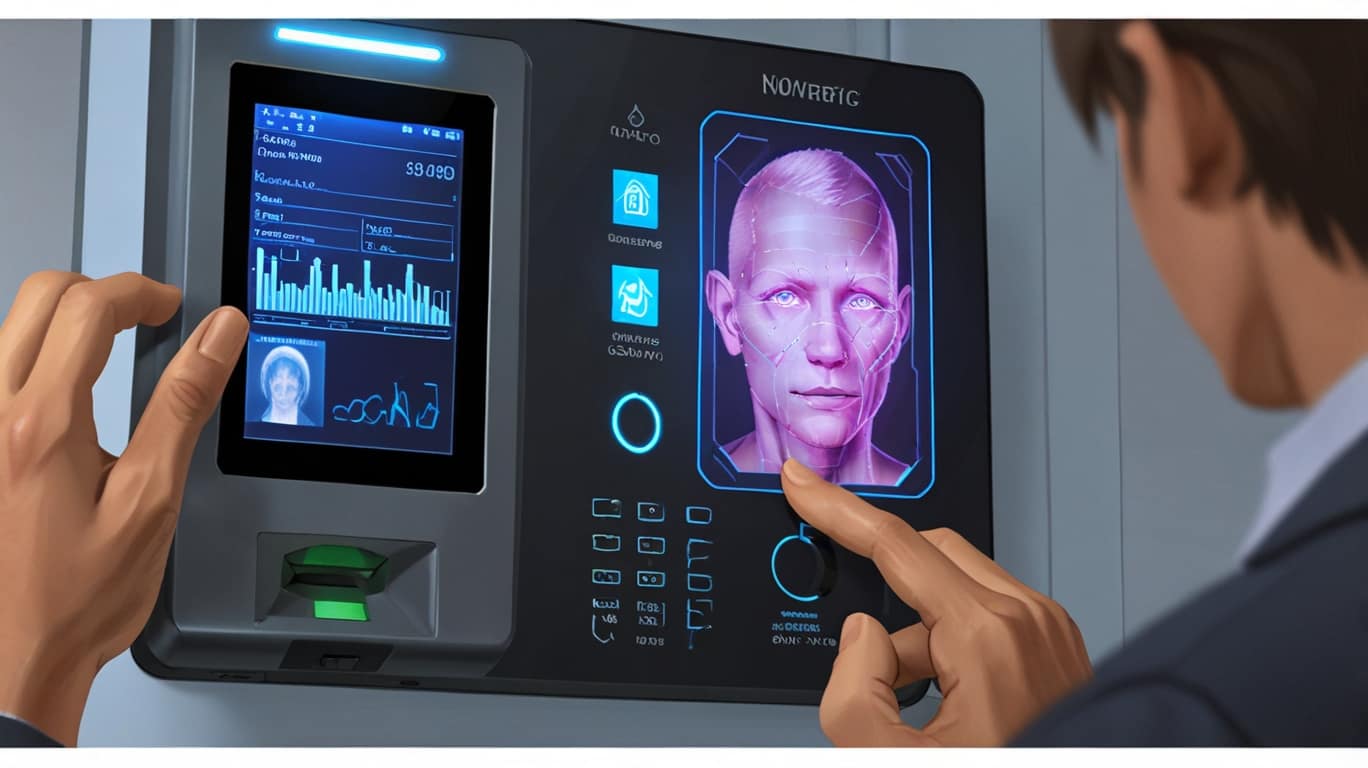Modern LED Headcount Display System
[ Contact us on +91-9898067783 or sales@smginfotech.com for a comprehensive and Enterprise-worthy turn-key solution for a Headcount application and LED display system. ]
The modern headcount application and LED display system is a transformative tool for effective workforce management. In this blog post, we will explore what these systems are, how they benefit organizations, the methods used to collect headcount data, the key features that make these systems indispensable, and how modern technology—especially in the context of India—can facilitate their implementation. Finally, we will wrap up with actionable insights and encourage you to consider the long-term benefits of such an investment.
AXIS Gatepass provides a feature packed Headcount application and LED display system to effectively manage people on premises (POP) compliance requirement. Contact us for a no-obligation demo, detailed requirement analysis, proposed solution, cost and implementation plan.
What is a Headcount Display System?
A headcount application and display system is a digital solution designed to track and manage the number of employees, visitors, and contract workers within an organization in real time. Unlike traditional methods such as manual registers or periodic supervisory counts, these systems use advanced technologies—ranging from biometric identification to mobile applications—to provide instantaneous and accurate data regarding who is on-site at any given moment.
The primary goals of a headcount system are
- Enhanced Safety: In emergency situations, knowing exactly how many people are on-site, and where they are, can be the difference between chaos and a well-coordinated evacuation.
- Operational Efficiency: With real-time data, companies can manage staffing levels effectively, ensuring that resources are allocated optimally.
- Regulatory Compliance: Many industries are required by law to maintain accurate attendance and headcount records for safety and labor regulation purposes.
- Data-Driven Decision Making: With access to real-time workforce data, organizations can make informed decisions that enhance productivity and reduce operational costs.
By automating the process of tracking employee attendance and visitor logs, these systems eliminate human error, reduce administrative overhead, and ensure that data is always up-to-date and readily accessible.
Benefits of Implementing a Headcount Display System
Modern headcount systems offer a host of benefits that extend well beyond simply counting heads. Let’s dive into the key advantages:
Enhanced Safety
Safety is paramount in any workplace, especially in large organizations or those with high-risk environments. With a headcount system in place:

Emergency Preparedness: In case of an emergency, such as a fire or natural disaster, having accurate headcount data enables quick and efficient evacuations. Emergency responders can use the system to verify that everyone is accounted for.

Headcount Display Board: Systems can be configured to trigger alarms or alerts if the number of people in a particular area exceeds a safe threshold, or if unexpected movement is detected in restricted zones.
Improved Resource Allocation
Understanding your workforce in real time allows for smarter resource management:
- Optimized Staffing: Managers can adjust shift patterns and allocate personnel where they are needed most, reducing over-staffing or under-staffing scenarios.
- Cost Efficiency: By analyzing headcount data, companies can identify trends and adjust their operations to improve productivity and lower operational costs.
- Real-Time Decision Making: With immediate access to workforce data, decisions regarding resource allocation are no longer based on estimates but on solid, up-to-the-minute information.
Regulatory Compliance
Many industries face stringent regulations regarding employee tracking and safety:
- Accurate Record Keeping: A headcount system automatically maintains logs of employee attendance and visitor entry, ensuring that records are complete and up-to-date.
- Audit-Ready Data: In the event of an audit, having detailed historical data on headcounts and movements can help demonstrate compliance with industry and governmental regulations.
- Legal Protection: Proper documentation of workforce data can protect companies from potential legal liabilities in situations where accurate headcount information is crucial.

Data-Driven Decisions
One of the most powerful aspects of modern headcount systems is the wealth of data they provide:
Enhanced Productivity: Data-driven insights can help optimize workflows, streamline operations, and ultimately drive higher productivity levels across the organization.
Trend Analysis: Historical data can reveal trends in workforce behavior, helping organizations plan for future growth or anticipate seasonal variations.
Predictive Insights: With advanced analytics, companies can forecast future staffing needs and identify potential issues before they become problematic.
Methods to Collect Headcount Data
The evolution from manual to digital data collection has significantly improved the accuracy and efficiency of headcount tracking. Here are the main methods employed:
Manual Methods
Traditionally, organizations relied on methods such as:
- Registers and Sign-In Sheets: Employees and visitors would manually record their entry and exit. While simple, this method is prone to errors and is time-consuming.
- Supervisor Counts: Supervisors or designated personnel would count individuals in specific areas. This approach is not only inefficient but also inaccurate, especially in large facilities.
Digital Solutions
Modern technologies have revolutionized data collection:
- Mobile Applications: Employees can use mobile apps to check in and out, which then automatically update the headcount in a central database. This method is convenient and reduces administrative workload.
- Biometric Systems: These systems use fingerprint, facial recognition, or iris scanning to verify identities and record attendance. Biometrics ensure a high level of accuracy and reduce the possibility of fraud.
- RFID/NFC Technologies: Radio-frequency identification or near-field communication technologies enable contact-less tracking of employees and visitors, streamlining the data collection process.
Visitor Management Systems
Specialized visitor management systems are designed to handle the unique challenges of tracking non-employees:
- Pre-Registration: Visitors can pre-register online, ensuring that the system is prepared for their arrival.
- Badge Printing and Logging: Upon entry, the system issues a badge and logs entry/exit times, ensuring that visitor data is accurately recorded.
- Integration with Security Systems: Many visitor management solutions integrate with surveillance and access control systems, further enhancing security.
Integration with Existing Systems
For a seamless experience, headcount systems can be integrated with other organizational systems:
- HR Systems: Integration with human resource management systems ensures that attendance data feeds directly into payroll and performance metrics.
- Payroll Systems: Automating the flow of attendance data to payroll systems minimizes errors and ensures that employees are paid accurately.
- Enterprise Resource Planning (ERP): Integration with ERP systems allows for a holistic view of the organization’s operations, improving overall decision-making.
Important Features of a Headcount System
A robust headcount system should offer a variety of features that ensure accuracy, ease of use, and flexibility. Here are some key attributes to consider:
Real-Time Tracking
Immediate Data Updates: The system should provide real-time updates, ensuring that the latest headcount data is always available. This is critical during emergencies and for daily operations.
Automated Alerts: Alerts can notify managers of any discrepancies or anomalies in headcount, enabling immediate corrective action.
User-Friendly Interface
- Intuitive Dashboards and display boards: Both administrators and employees should find the interface easy to navigate. Dashboards should provide clear visuals and straightforward access to data.
- Mobile Accessibility: Given the on-the-go nature of many modern workplaces, the system should be accessible via mobile devices without sacrificing functionality.
Reporting and Analytics
- Comprehensive Reports: The system should generate detailed reports that offer insights into workforce trends, attendance patterns, and resource utilization.
- Customizable Analytics: Users should be able to tailor reports to focus on specific metrics that are important to their operations.
Integration Capabilities
- API Access: The system should offer robust APIs to allow seamless integration with other software systems such as HR, payroll, and ERP solutions.
- Data Synchronization: Ensuring data flows accurately between systems reduces manual errors and enhances overall efficiency.
Customization Options
- Industry-Specific Adaptability: Whether you are in manufacturing, healthcare, education, or any other sector, the system should be customizable to meet your unique needs.
- Flexible Retention Policies: The ability to configure data retention periods based on regulatory requirements or organizational policies adds value and compliance assurance.
How Modern Technology Can Help Implement Headcount Systems in India
India’s dynamic business environment presents unique challenges and opportunities for implementing headcount systems. Modern technologies are key to addressing these challenges effectively.
Cloud-Based Solutions
Remote Accessibility: Cloud-based systems enable access to headcount data from anywhere, making it easier to manage a geographically dispersed workforce.
Scalability: As organizations grow, cloud solutions can scale seamlessly without the need for significant additional capital expenditure. Cost-Effective: Cloud technology reduces the need for on-premise hardware and maintenance, offering a more economical solution for organizations of all sizes.


Mobile Applications
Ease of Data Entry: Mobile apps simplify the process of recording attendance, whether employees are working from the office or remotely.
Instant Communication: Mobile solutions enable real-time communication between employees and management, ensuring that any issues with attendance data are quickly resolved.
User Engagement: An intuitive mobile interface encourages consistent use, improving data accuracy and overall system efficiency.
Biometric Systems
Enhanced Accuracy: Biometric identification minimizes the risk of proxy attendance and ensures that the data collected is accurate.
Security: Biometric systems provide an additional layer of security, safeguarding sensitive employee data and ensuring that only authorized personnel can access the system.
Compliance: These systems help meet regulatory requirements by ensuring that attendance records are tamper-proof and verifiable.


AI and Machine Learning
Predictive Analytics: AI can analyze historical headcount data to predict future trends, helping organizations plan their staffing needs more accurately.
Anomaly Detection: Machine learning algorithms can identify irregularities in attendance patterns, flagging potential issues before they become significant problems.
Continuous Improvement: Over time, AI can learn from the data and continuously optimize the system, enhancing both accuracy and efficiency.
Case Studies: Implementation in India
- Manufacturing Sector: Several large manufacturing companies in India have implemented digital headcount systems to manage their extensive workforce. These systems have improved safety protocols by ensuring that emergency evacuations are more efficient.
- Corporate Offices: Many corporate offices have adopted cloud-based headcount applications to monitor employee attendance, reducing administrative burdens and ensuring compliance with labor regulations.
- Educational Institutions: Universities and large schools in India are using headcount systems to monitor student attendance in real time, thereby improving campus security and operational efficiency.
- Healthcare Facilities: Hospitals and clinics have implemented headcount and visitor management systems to ensure that only authorized individuals access restricted areas, enhancing overall security and patient safety.
The success of these implementations is a testament to the benefits of adopting modern headcount solutions in the Indian context. Companies across various sectors have reported improved operational efficiency, better resource allocation, and a higher degree of compliance with safety regulations.
In conclusion, the modern headcount application and display system is a powerful tool that revolutionizes workforce management. From enhancing safety and regulatory compliance to improving resource allocation and enabling data-driven decisions, these systems offer substantial benefits that can transform the way organizations operate.
By leveraging modern technologies such as cloud computing, mobile applications, biometrics, and AI, companies in India can overcome traditional challenges associated with manual headcount methods. These systems not only provide real-time, accurate data but also integrate seamlessly with existing HR, payroll, and ERP systems to offer a holistic view of organizational performance.
For organizations aiming for long-term growth, investing in a modern headcount system is more than just a technological upgrade—it is a strategic move towards creating a safer, more efficient, and ultimately more productive work environment. The data-driven insights provided by these systems can lead to better decision-making, ensuring that businesses are always one step ahead in a competitive landscape.
As the business environment continues to evolve, so too must the methods we use to manage our workforce. Modern headcount solutions offer a glimpse into the future of work—one where technology and human resource management converge to drive sustained success and innovation.
We invite you to share your thoughts and experiences regarding headcount management. Have you implemented a digital headcount solution in your organization? What challenges and benefits have you encountered? If you’re interested in learning more about how a modern headcount application and display system can transform your workforce management, feel free to reach out to us for a consultation. Let’s work together to revolutionize the way we manage and safeguard our most valuable asset—our people.
By embracing modern headcount solutions, you’re not only investing in technology but also paving the way for a safer, more responsive, and ultimately more successful organization. The future of workforce management is here, and it’s time to take the next step toward a smarter, more connected workplace.
Disclaimer: The perspectives and recommendations shared in this post are based on industry trends and the evolving needs of modern organizations. Please consult with our sales and technical experts to tailor our solution to your specific business needs.
Visit for more such Facility management solutions

